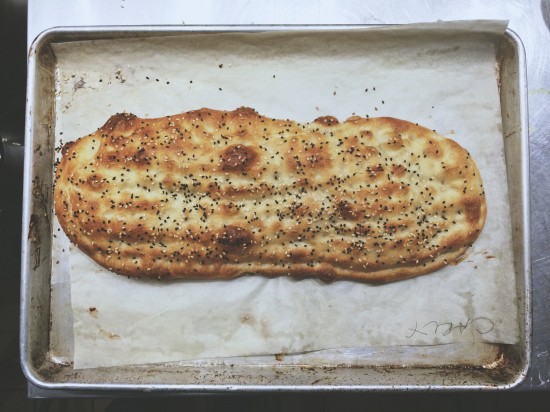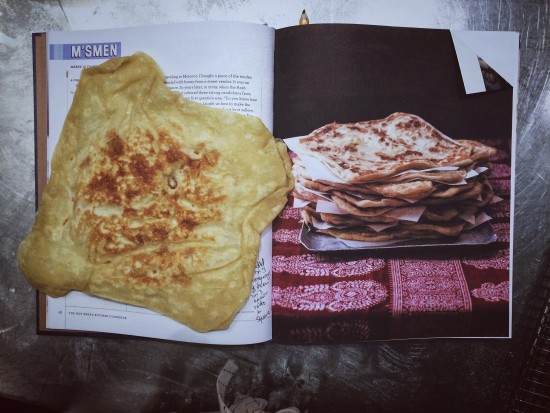
The Global Breads of Hot Bread Kitchen
Breaking bread may be the traditional cornerstone of any feast, but I’ve always found it to be one of the more intimidating—and time-consuming—food products to make by hand. Beyond the naturally leavened, French-style bread that consumes so much of the current culinary conversation is a whole world of international loaves—many of which are far easier to recreate at home.

In New York City, Hot Bread Kitchen is the leading purveyor of unique global breads. Known as much for their social mission—providing job training to female immigrants, many of whom have gone on to work in the city’s top bakeries—as for their products, HBK has become a staple at the city’s markets and upscale groceries. I have been a longtime fan of the brand’s Moroccan m’smen—which sells like hot cakes—so I was delighted to learn that the team would be sharing their recipes for the m’smen and other international breads in a hands-on class at ICE.
While anyone can purchase an entire cookbook of Hot Bread Kitchen’s diverse recipes, taking an in-person class with HBK founder Jessamyn Waldman Rodriguez and the director of the Bakers in Training program, Karen Bornarth, was incredibly helpful. As Karen walked us through each recipe, she shared tips for home cooks working without a stand mixer and bakery deck ovens. She also explained how those of us with busy schedules could break up the baking process into steps (see "notes" in the recipe below), making the dream of home bread baking all the more possible.
Since that night at ICE, I’ve mixed, shaped and fried several batches of m’smen by hand, without a stand mixer! For this ambitious home cook, the dream of homemade bread is finally a reality, and I can’t wait to test out more of Hot Bread Kitchen’s inspiring international recipes.
Click here for upcoming baking classes at ICE or learn more about our professional bread baking program at ICE.edu/BREAD.

Recipe
M’smen
Makes 12 (7-inch/18-cm) squares
Ingredients
- 4 cups/500 g all-purpose flour, plus more for shaping
- ½ cup plus 2 tablespoons/100 g Semolina, plus more for shaping
- 1½ teaspoons kosher salt
- 1¾ cups/400 g water
- 2 teaspoons, plus 6 tablespoons/95 g canola oil, plus more for shaping
- 6 tablespoons/85 g salted butter, melted
Directions
- Put the flour, semolina and salt in the bowl of a stand mixer fitted with a dough hook. Add the water and 2 teaspoons/10 g of the oil and, with the mixer on low, mix until everything is combined well, about two minutes. Increase the speed to medium and mix until the dough is smooth, shiny, elastic, and pulls away from the sides of the bowl, about six minutes. (Note: If mixing by hand, gradually incorporate the dough into your dry ingredients in the bowl with a spatula. Once all the water has been added, knead by hand for about two minutes. The dough may look a bit shaggy, but will improve upon resting.)
- Generously coat a rimmed baking sheet with oil. Coat a large, smooth work surface with oil (a granite, stainless steel or Formica countertop is ideal). Transfer the dough to the oiled surface. Using oiled hands, form a ring with your thumb and index finger and use it to squeeze off pieces of the dough into 12 equal balls (each should weigh about 3 ounces/85 g). Put the balls on the oiled baking sheet and roll them around so that they’re coated with oil, but keep the balls separate from one another. Put the entire baking sheet in a large plastic bag or cover loosely with plastic wrap and let the dough rest at room temperature for 30 minutes. (Note: those with busy schedules can chill dough overnight in the refrigerator. Simply remove the baking sheet from the refrigerator 30 minutes before continuing on to step three.)
- Meanwhile, put the remaining 6 tablespoons/85 g oil in a small bowl, add the melted butter and stir to combine.
- Re-oil the work surface. Working with one piece of dough at a time, use the palm of your hand to flatten the ball and then continue to apply downward pressure with your palm to stretch it out into a rough circle about 10 inches/25 cm across—so thin it’s nearly translucent.
- Using your hand, cover the surface of the dough with 1 tablespoon of the butter mixture and then sprinkle with a dusting (about 1 teaspoon) of semolina. Use a rubber spatula to lightly mark the midline.
- Fold the top of the dough circle down so that the edge extends about ½ inch/1.5 cm beyond the line. Repeat that fold from the bottom so that the two edges overlap the center. Then fold in each of the other sides in the same way to form a 3-inch/7.5 cm square. Transfer the m’smen squares to the oiled baking sheet seam side down and let rest for at least 15 minutes. Form the remaining bread in the same manner, warming the butter mixture if it begins to solidify.
- Proceeding in the same order in which you formed the bread, put each square on a lightly oiled piece of parchment paper and stretch it with your palm until it has slightly more than doubled in size. If it resists stretching, let it rest a bit more before proceeding. Each finished m’smen should be a 7-inch/18 cm square. Cut the parchment so that it extends just slightly beyond the square. Do not stack the bread as you stretch them—they will stick together.
- Heat a large griddle over medium-high heat until a drop of water sizzles away almost immediately.
- You can cook as many m’smen as your skillet or griddle will hold at a time. Lay the bread paper side up in the skillet and then peel off the paper as soon as the bread begins to firm—it will come away easily. Cook the m’smen until it turns first translucent and then brown in spots, two to three minutes per side. Transfer to a wire rack while you continue cooking the rest.
- M’smen is most delicious eaten warm, but once cooled it can be stored for up to five days in an airtight container in the refrigerator. It freezes well for up to three months. Reheat m’smen for one minute on each side in a hot, dry skillet before serving.
Reprinted from The Hot Bread Kitchen Cookbook. Copyright © 2015 by Jessamyn Waldman Rodriguez. Photos copyright © by Jennifer May and Evan Sung. Published by Clarkson Potter, an imprint of Penguin Random House, LLC.


Add new comment